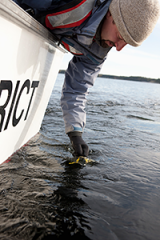Types of Drinking Water Contaminants

The Safe Drinking Water Act defines the term "contaminant" as meaning any physical, chemical, biological, or radiological substance or matter in water. Therefore, the law defines "contaminant" very broadly as being anything other than water molecules. Drinking water may reasonably be expected to contain at least small amounts of some contaminants. Some drinking water contaminants may be harmful if consumed at certain levels in drinking water while others may be harmless. The presence of contaminants does not necessarily indicate that the water poses a health risk.
Only a small number of the universe of contaminants as defined above are listed on the Contaminant Candidate List (CCL). The CCL serves as the first level of evaluation for unregulated drinking water contaminants that may need further investigation of potential health effects and the levels at which they are found in drinking water.
The following are general categories of drinking water contaminants and examples of each:
- Physical contaminants primarily impact the physical appearance or other physical properties of water. Examples of physical contaminants are sediment or organic material suspended in the water of lakes, rivers and streams from soil erosion.
- Chemical contaminants are elements or compounds. These contaminants may be naturally occurring or man-made. Examples of chemical contaminants include nitrogen, bleach, salts, pesticides, metals, toxins produced by bacteria, and human or animal drugs.
- Biological contaminants are organisms in water. They are also referred to as microbes or microbiological contaminants. Examples of biological or microbial contaminants include bacteria, viruses, protozoa, and parasites.
- Radiological contaminants are chemical elements with an unbalanced number of protons and neutrons resulting in unstable atoms that can emit ionizing radiation. Examples of radiological contaminants include cesium, plutonium and uranium.
